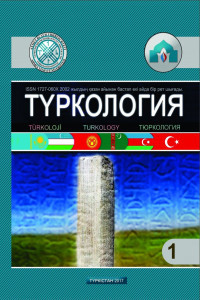MİLLÎ UYANIŞ DÖNEMİ ÖZBEK ŞİİRİNDE MİLLET RUHUNUN BETİMLENMESİ
Edebiyat giderek sosyal hayata yaklaştıkça, geleneksel türler biçimlerini korurken, “merdikarlık” (yevmiyeci işçi) şiirinin içindekileri değişti; manevi-mistik ve romantik motiflerin yerini sosyopolitik motifler, sembolik görüntülerin yerini gerçek bir kişinin görüntüleri aldı. Merdikarlık olaylarına adanan şiir, şairin sübjektif duygularını acıma düzeyine çıkaran acı ve kin, ironi ve öfkenin yanı sıra o dönemin toplumsal sorunlarını, halkın en derin düşüncelerini de yansıtmıştır. Merdikarlık şiirinde gerçekçi görüntü esas olarak olay, prototip, pathos'ta yansıtılır. Özellikle, 1916 ayaklanmasının trajedileri, insanların cephe arkasında çalışmaya gönderilmeleri, sürgündeki yaşamın acıları, olaylarının sanatsal yorumunun örnekleridir. Nikolai, Rasputin, Ivanov, Mochalov gibi görünüşler prototipleri ve davranışları tasvir eder. Yazarların ulusal kurtuluş hareketiyle ilişkili estetik ideallerini yansıtan ideolojik ve duygusal imaj, gerçekçi bir pathos yarattı. Merdikarlık şiirinin gerçekçi pathos içindeki ifadesi, özellikle Sidki'nin eserinde canlı bir şekilde tezahür etti. "Rus Devrimi" şiirindeki trajik, hicivli, eleştirel pathos’ta bu fikri destekler.
Anahtar Kelimeler:
Geleneksel Biçim, Geleneksel Tür, Aruz Vezni (Ölçüsü), Parmak Şiir Sistemi, Merdikarlık Şiirleri, Nekaretli Şiir, Novatorluk, “Aralık Vezin”, Pafos, Prototip, Real Yaklaşım, Ritmika
Depicting the National Spirit in Uzbek Poetry of the National Awakening Period
As literature increasingly approached public life, the content of the poetry of mardikery changed, while retaining the forms of traditional genres; spiritual-mystical and romantic motives were replaced by socio-political motives, symbolic images were replaced by images of a real person. Poetry dedicated to the events of mardikery reflected the social problems of that time, the innermost thoughts of the people, as well as pain and hatred, irony and anger, which raised the poet's subjective feeling to the level of pathos. In the poetry of mardikery, the realistic image is reflected mainly in the event, prototype, pathos. In particular, the tragedies of the 1916 uprising, being sent to work behind the front, the suffering of life in exile are examples of an artistic interpretation of the event, and such images as Nikolai, Rasputin, Ivanov, Mochalov depict prototypes and their behavior. The ideological and emotional image reflecting the authors' aesthetic ideals associated with the national liberation movement created a realistic pathos. The expression of the poetry of mardikery in realistic pathos was especially vividly manifested in the work of Sidki. The tragic, satirical, critical pathos in the poem "Russian Revolution" also confirms this idea.
Keywords:
Traditional Form, Traditional Genre, Aruz, Barmok System, Poetry Of Mardikery, Poem With Choruses, Innovation, “Intermediate” Metric, Pathos, Prototype, Realistic Approach, Rhythm,
___
- 1. Jalolov A. Ўzbek marifatparvar-demokratik adabiёti. – Toşkent: Fan, 1978. – 168 b.
- 2. Boltaboev Ҳ. Fitrat va jadidchilik. İlmii-tadqiqii maqolalar. – Toşkent: Millii kutubhona, 2007. – 286 b.
- 3. Qosimov B. Millii uiğoniş: jasorat, marifat, fidoiilik. – Toşkent: Manaviяt, 2002. – 400 b.
- 4. Millii uiğoniş davri ўzbek adabiёti / B.Qosimov, Ş.supov, U.Dolimov va b. – Toşkent: Manaviяt, 2004. – 464 b.
- 5. Akbarov Abduraҳmon ҳoji Toşkandii. Vatanga hidmat. – Toşkent: Erşod kut-si, 1917. – 24 b.
- 6. Mulla Murtazo bin İsmoiljon. Vatan hizmati. – Toşkent, 1917. – 12 b.
- 7. Tirik satrlar. Tanlangan şerlar. Tўplovchi M. Zokirov. – Toşkent: Badiii adabiёt, 1968. – 480 b.
- 8. Sarimsoqov B. Badiiilik asoslari va mezonlari. – Toşkent: Fan, 2004. – 128 b.
- 9. Karimov E. Razvitie realizma v uzbekskoi literature. – Taşkent: Fan, 1975. – 192 s.
- 10. Hondailiqii Sidqii. Rusiя inqilobi. – Toşkent: Ravnaq kut-si, 1917. – 48 b.
- 11. Dokumenty stavki E.İ.Pugachёva, povstancheskih vlastei i uchrejdenii. 1773-1774 gg. – M.: Nauka, 1975. – S. 23.
- 12. Rudneva E.G. Pafos hudojestvennogo proizvedeniя (iz istorii problemy). – M.: Moskovskii universitet, 1977. – 164 s.
- 13. Julqunboi. Mochalov // Qizil bairoq, 1922, 26 avgust. - № 212.
- 14. Turkiston chor Rossiяsi mustamlakachiligi davrida. Ўzbekistonning яngi tarihi. Birinchi kitob. – Toşkent: Şarq, 2000. – 464 b.
- 15. Kastelskaя Z.D. Osnovnye predposylki vosstaniя 1916 goda v Uzbekistane. – M.: Nauka, 1972. – 146 c.
- 16. Asilov A. Şoir Sidqii Hondailiqii ҳaёtidan lavҳalar // Şarq lduzi. – Toşkent, 1979. - № 6.
- 17. Soliҳov T. Millii adabiёtlarda sosialistik realizm metodining şakllanişiga doir / Adabiёtimizning яrim asri. – Toşkent: Adabiёt va sanat, 1975.
- 18. Gulяev N.A. Teoriя literatury. – M.: Vysşaя şkola, 1985. – 272 s.
- 19. Ўzbek adabiёti. Tўrt tomlikka ilova. Beşinchi tom. İkkinchi kitob. – Toşkent: Badiii adabiёt, 1968. – 352 b.
- ISSN: 1727-060X
- Başlangıç: 2002
- Yayıncı: Hoca Ahmet Yesevi Uluslararası Türk-Kazak Üniversitesi
Sayıdaki Diğer Makaleler
KAZAK HALKININ KIZ EĞİTME GELENEĞİYLE İLGİLİ TEMEL İLKELER
MİLLÎ UYANIŞ DÖNEMİ ÖZBEK ŞİİRİNDE MİLLET RUHUNUN BETİMLENMESİ
KAZAKİSTAN’DA SOVYET DEVRİNDEN BAĞIMSIZLIK DÖNEMİNE DEĞİŞEN KAZAK EDEBİYATI
İBRAHİM TIRSÎ DİVANI’NDA YEMEK ADLARINA AİT SÖZ VARLIĞI ÜZERİNE BİR DEĞERLENDİRME
KAZAK HALKININ SÖZEL OLMAYAN İLETİŞİM MODELİNİN ÖZELLİKLERİ
EL-FARABI'NİN SİYASİ VE ETİK GÖRÜŞLERİNDE BAZI FELSEFİ FİKİRLER
